Happy New Year, everyone! Mark, Maya, and I wish you all a healthy, productive, inquisitive, comfortable, and adventurous 2025. Thank you for following Roaming About and appreciating that crazy lifestyle of ours.
I finally finished my Patagonia wildlife post, which contains lots of photos and videos. This footage hopefully gives you a better representation of our incredible encounters. Enjoy!
After “killing” a month of time in and around Uruguay in anticipation of less cold weather in the south, Mark and I deemed November 1st a good time to cross the border into Argentina again and head to Patagonia along the Atlantic Coast. It was still spring in the Southern Hemisphere, but the goal was to reach Ushuaia, the bottom of the continent, by December 21st, the start of the austral summer.
(As always, hover over or click on the photos in the galleries to read their captions.)
We had a rough start of this 2,500-mile (3,750km) southbound journey in Gualeguaychú with lack of sleep due to a motorcycle event with revving engines until 2am and youth partying behind our camper at 4am. We packed up and moved in the dark to settle at a fuel station by 5:15am.
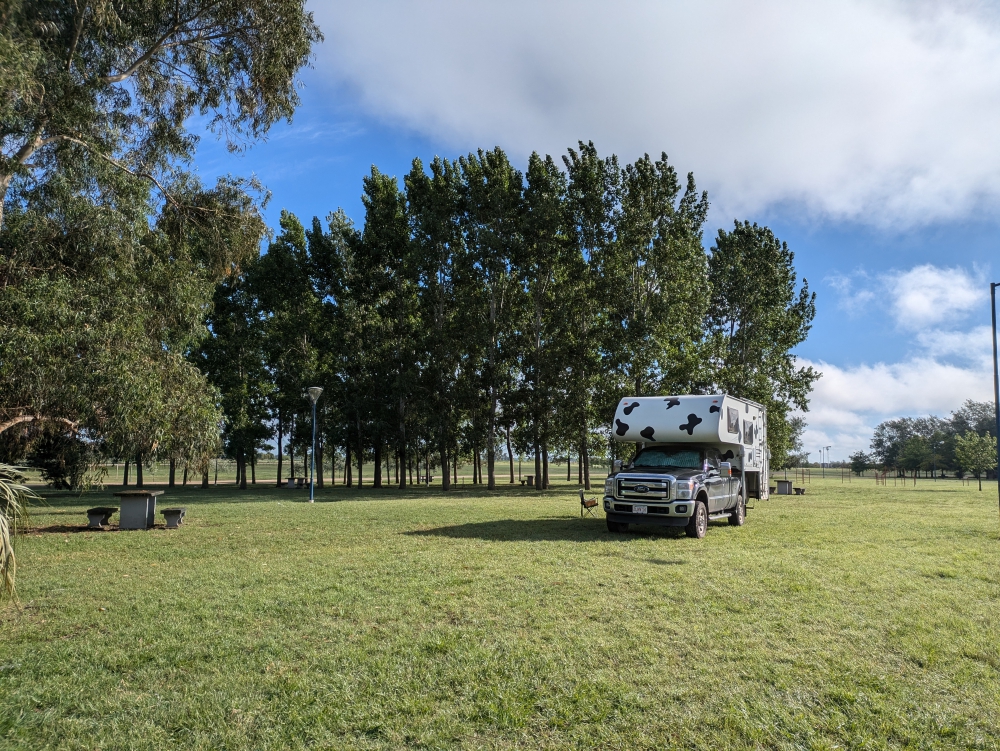
This park was quiet!
This was followed by hours of driving and eventually settling in a nice and free municipal campground for a few days to work. After that commitment, the three of us started to cover miles along a boring Ruta 3, stopping at a few points of interest and stocking up on groceries before reaching a more remote and expensive Patagonia.
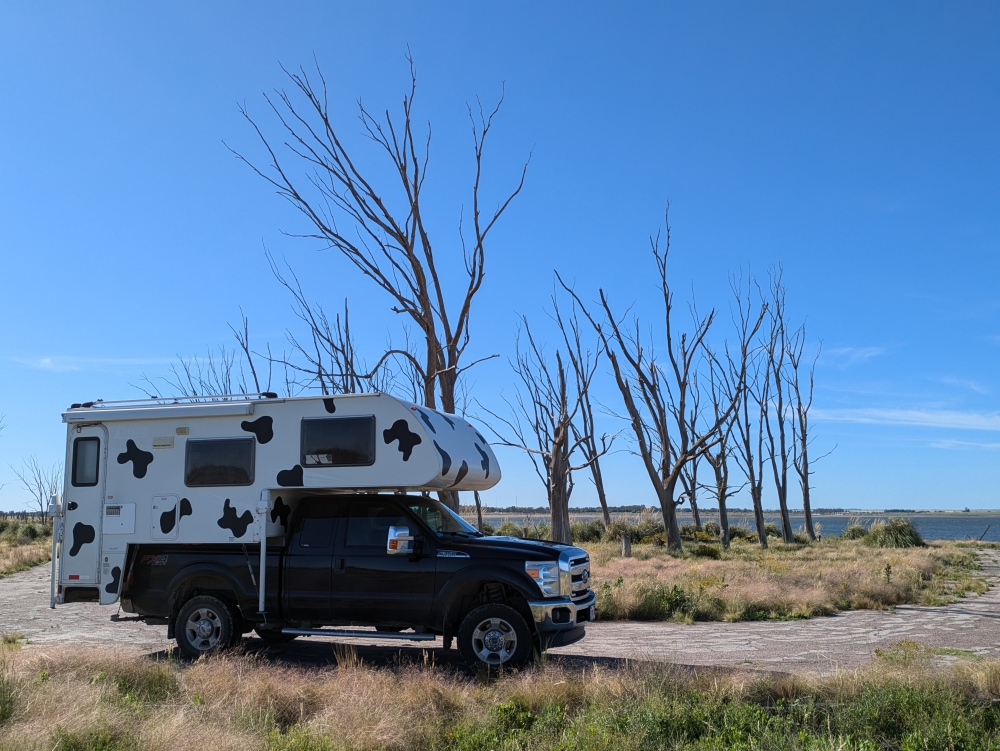
Eerie camp spot
One of the interesting sites we picked for a visit was Laguna de Epecuén, which draws tourists because of its eerie appearance. On November 6th, 1985 (exactly 39 years prior to our visit), an unusual weather pattern destroyed the dam and dike protecting the village of Villa Epecuén, flooding the area. This resort destination was never rebuilt and became a ghost town. Skeletal trees stand guard day and night, enhancing the barren scenario.
Most overlanders drive to Ushuaia via the Andes Mountains that straddle the Argentinian-Chilean border, which is a more scenic route than our choice near and along the Atlantic Coast. There are three reasons we picked this “faster” and “boring” side of the continent: we were already located in the east when starting the last stretch of our journey south, we hoped to spend most of the summer in the Andes on our drive back north, and this route offered wildlife encounters.
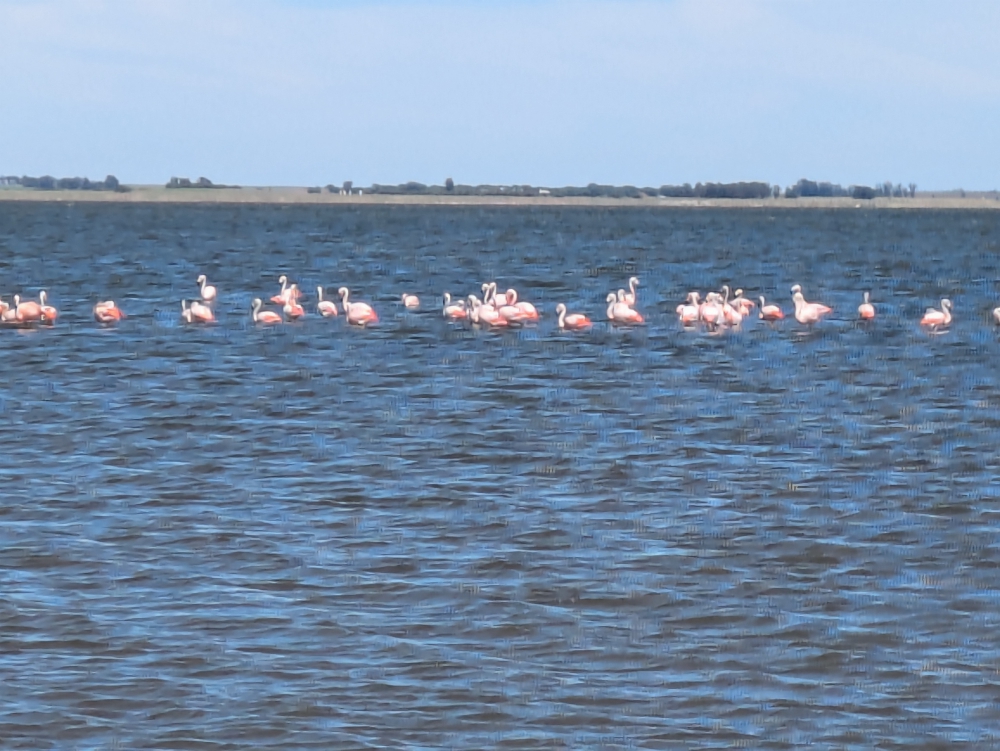
Flamingos on Epecuén Lake
Besides the random flamingoes, no interesting animals had crossed our path yet. That was about to change in Balneario El Condor, located at the northern edge of Patagonia. This, we learned after going through multiple agriculture checkpoints. We arrived in the province of Rio Negro on El Dia de la Tradicion (November 10th) and were greeted by cute children offering goodies and cheaper fuel!
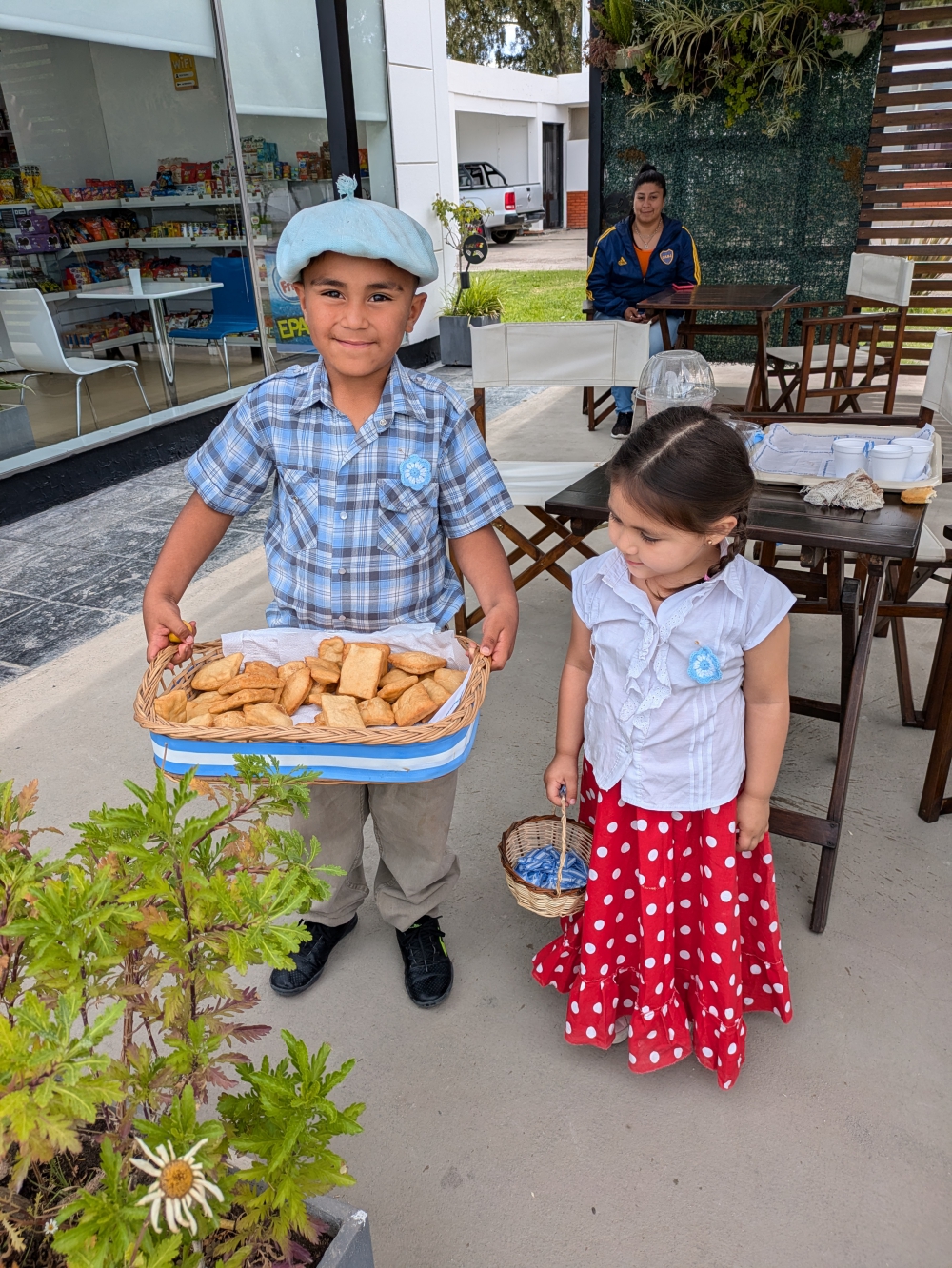
Local treats for Dia de la Tradicion
El Condor might be located off the beaten track, but we really recommend a stop here if you have your own vehicle. This is where the biggest colony of burrowing parrots in the world is situated.
Miles of cliffs are inhabited by these pretty, squawking birds that are a delight to witness. Yes, they are loud! Luckily, they go to sleep at night, but the nights at this time of the year are short. They made sure we went to bed with them and woke up with the first sunrays!
One day, we walked along the beach for a first glimpse of these birds. That evening, we climbed a hill for happy hour with a view – of the sea and the parrots.
Then, we moved to a new camping spot on the cliffs and observed the colony from above. The following morning, the wind had picked up and we witnessed them soar above us from the beach. So cool!
We followed a scenic, gravel, coastal road and camped on a bluff by ourselves. To our surprise, the same breed of parrots still nested here and kept us company, many miles away from El Condor. After three nights among these fascinating creatures, it was time to move on.
Why would we leave the main road, Ruta 3, for a detour along the coast on a 100km gravel road? To enjoy the scenery, find remote and quiet camping spots, and drive slower and shorter distances into a strong headwind! Often, the winds in Patagonia come from the south, from chilly Antarctica. Along this stretch, we spotted sea lions and guanacos and played in the sand dunes.
So far, we had been okay with the strong winds Patagonia is famous for, but once we reached Puerto San Antonio Este and further south, we needed to start planning around its velocity. We parked with our nose towards the SW, tried to find some protection, and decided to stay put when it blew too hard, avoiding our fuel consumption from getting even worse.
On one of those days at a shell beach, the wind turned 180 degrees, from the south to the north, and within 20 minutes the outside temperature changed from 58 degrees (14C) to 88 degrees (31C)!!! It was one of the weirdest things we ever experienced.
Another long day of driving brought us to the city of Puerto Madryn, the jumping-off point for the Valdes Peninsula, which teems with wildlife. The entire peninsula is a national park, for which you pay $30 per person to enter. Yes, we wanted to see elephant seals, whales, and orcas, but we weren’t willing to pay $60 for that privilege.
Our first plan of action in this city was to get our pantry cabinet fixed, which had fallen off its tracks on bad roads. We also needed to buy food, drop off laundry, and finish job assignments. In between all that, we parked on beaches and waited patiently (while completing other projects) for whales to appear. In vain.
Despite arriving late in the whale watch season, we had one more lead to potentially spot whales: Punta Ninfas, a natural area at the end of a gravel/sandy road that could turn into mud after heavy rains. Therefore, it was a tricky destination, another 100 km east of Puerto Madryn. The drive there was surprisingly easy and took only two hours.
Our camping spot on the cliff was pretty and the sun was out that first day, but we didn’t see whales or orcas, just a colony of elephant seals on the beach below us. That evening a Border Collie with a collar showed up. We assumed it belonged to a neighboring farm. At night, the wind blew so strong that our camper shook as if we were sailing on rough seas. And, yes, I did get seasick!
The following morning, I had to work, but the people “on watch” for sea creatures spotted a pod of orcas. By the time I put more clothes on and rushed outside, I could only see their fins through binoculars. A storm was predicted, so the other campers headed out to avoid getting stuck in the mud. The loose dog was left behind, so we took care of her with love, food, water, and shelter.
On our last day at the point, Mark and I descended the cliff to observe the elephant seals on the beach. It was a great experience to just sit and watch them… mostly sleep!
Nobody stopped by or looked for the Border Collie (we named her Ninfa) and trying to find her owner – with the help of an Argentinian friend – was fruitless. So, we spent days online – mainly on local animal groups on Facebook – in an attempt to rehome her. Once we confirmed a family who would take her in, we all returned to Puerto Madryn. The sandy road had become treacherous with many puddles and detours and our new charge, who traveled on my lap, got car sick and puked. The ride took three hours this time.
Back in the city, we met Ninfa’s new family and handed them extra goodies, like a leash, flea and tick shampoo, and a blanket. It was a heart-warming experience all around after an emotionally draining and stressful period.
Another surprise awaited us in the evening, when Canadian friends, Sheri and Jeff, joined us sooner than expected.
Together, we visited the Welsh village of Gaiman for a traditional “high tea” ceremony and to explore the historical sites.
On the drive to Gaiman, we made a quick stop in Trelew to check out a huge replica of the biggest dinosaur in the world.
Sheri and Jeff also met us at the pretty El Farallon rock to camp and then celebrate my birthday in Puerto Deseado, a sizeable detour from Ruta 3. I forgot that November 28th was also the fourth anniversary of my memoir, Plunge!
I had hoped to join a penguin tour to Isla Pingüino with Mark, hence the detour, but once there, we learned that the prices had gone up from $80 per person to $140! After a discount… If I’d known that ahead of time, we probably would have skipped this area. But we seem to be two of the few overlanders who actually update the iOverlander app, instead of just using it.
But now that we were here and it was my special day, Mark suggested that I’d go nevertheless. Sheri joined me and the men stayed home.
Luckily, we found a pretty place to camp and walk Maya.
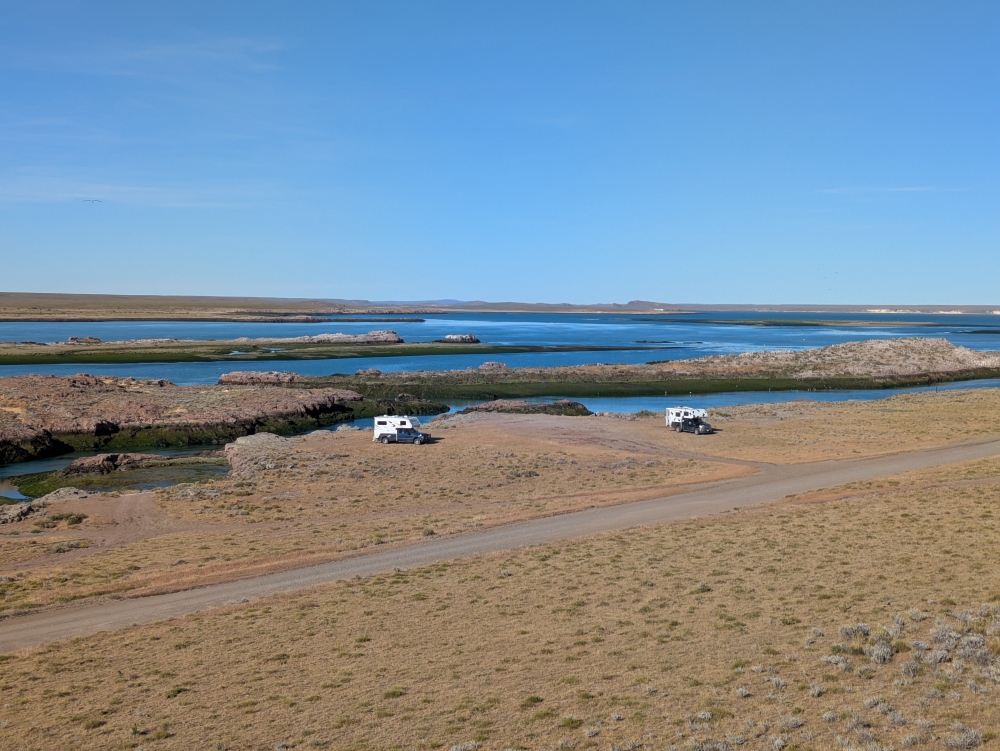
Camped away from the city in Puerto Deseado
The tour was enjoyable and special, but the price, really, was way too high for three hours on an island (and a two-hour boat ride) to observe Rockhopper penguins, as all the other species (Magellanic penguins, seals, and sea lions), we’d see or seen in the wild elsewhere.
Of course, all the wildlife encounters were still magnificent and unique.
The following days were consumed by stronger winds, taking the weather into account when driving, decent camping spots, more work, and switching hosting sites for this blog, which was not an easy matter.
Then, our quest to see penguins continued at Punta Quilla near Puerto Santa Cruz, where an hour-long walk over a pebble beach brings you to a colony of Magellanic penguins. In this habitat, the eggs had produced chicks, so it was amazing to watch and listen to the nesting birds.
A quick stop at Monte Leon National Park offered Mark more glimpses of this penguin species, while I stayed home with Maya. December 4th was her birthday and she deserved a more fun day than hours upon hours of driving on gravel roads (with scary rocks pouncing on the metal of the car) or being left alone for a couple of hours again. This was her day!
(Turn up the volume in the next video to hear the strange sound – like braying donkeys – these penguins make.)
Rio Gallegos is a big city towards the bottom of the Argentinian mainland. It was a good place to run errands (laundry, grocery shopping, buying parts, continuing the hosting switch, creating family calendars for 2025…), work, and get Maya’s paperwork in order to cross the border into Chile.
After one loud and sleepless night along the waterfront, we managed to find a quieter place to camp over the weekend, well outside of town, and even fit in an oil change on a morning with less wind.
Entering the island of Tierra del Fuego (who knew it was an island?) struck a chord with me. It’s one of those places you learned about in geography class, that sounded exciting and remained a mystery, even more so than Patagonia. Until now! I was surprised to learn from Mark that there is no English translation for Tierra del Fuego. In Dutch, it’s called Vuurland – Land of Fire or Fireland.
First, we had to cross the border into Chile, before we could cross the channel by ferry onto Tierra del Fuego, which, by the way is split in half between Chile and Argentina. It’s a bit messy.
Mark, Maya, and I met our friends again, who booked a King penguin tour at a preserve on the Chilean side of the island. We – again – didn’t want to pay the high entrance fee and hoped to spot these creatures somewhere in the wild.
We spent the next night at a pretty lake, but, unfortunately, needed to leave that area sooner than planned due to predicted rains and gravel/sandy roads potentially making passage back into Argentina impossible.
Much more driving followed. Besides seeing plenty of guanacos along the gravel roads, we spotted the remains of ones that tried to jump the fences – which line properties along the main route on both sides – and got stuck to die a horrible death. Every time we saw an animal run away from the sound of our truck, we hoped they would jump over a lower fence or just run along it. Tense moments.
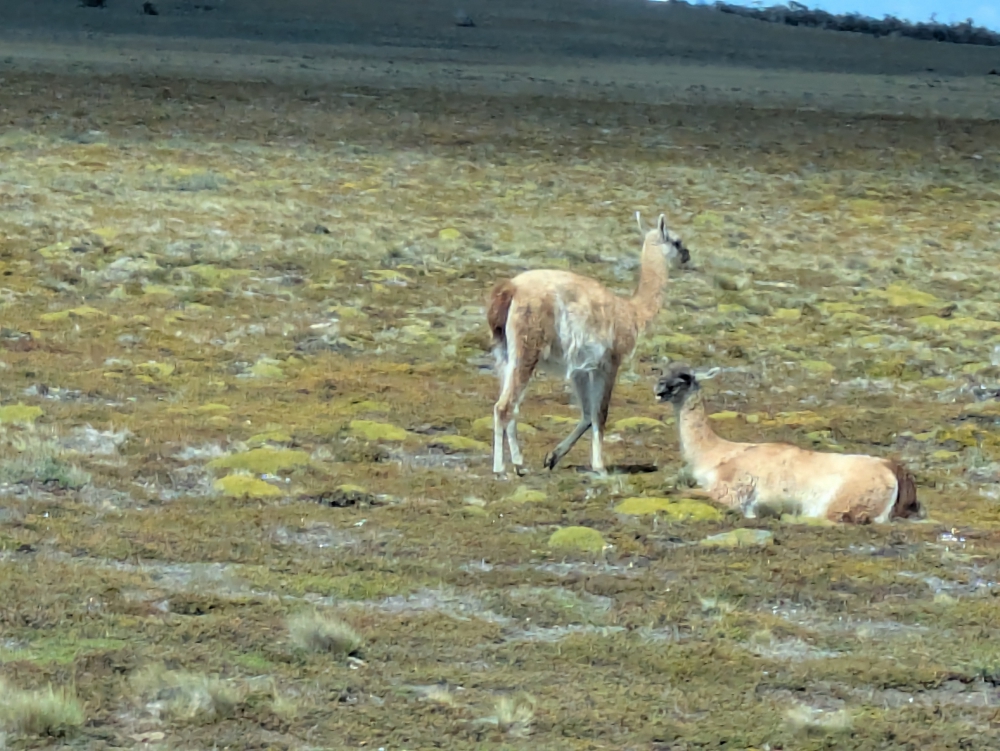
Guanacos on Tierra del Fuego
Crossing back into Argentina happened at a summer border post, which was super cute, quiet, fast, and convenient. We and our friends were the only travelers at that time and smiled at the laid-back yet efficient procedures.
For some reason, Mark and I dreaded arriving in Ushuaia, but weren’t sure why. True, we don’t like cities, we didn’t know what to expect, and it was “the end of the road” – and for many others, the end of their journey through the Americas. We preferred to linger and postpone that moment. So, we found a pretty, remote, and quiet camping spot by a lake, before reaching the big destination!
I’ll leave you with a short video of one of our drives with Thirsty Bella behind a herd of cows. 🙂
PS: This blog post has a lot of visual effects and might be slow to load. Please let me know if you experience issues, since it would be interesting to find out how our new hosting company deals with this.
Next up: Our expense report for December 2024
Curious about a previous ten-year chapter in our nomadic lives, which includes eight years aboard a 35-foot sailboat in the tropics with dogs, check out my compelling, inspiring, and refreshingly honest travel memoir:
Discover more from Roaming About
Subscribe to get the latest posts sent to your email.
























































































































































January 3, 2025 at 09:51
I’m getting ads from travel agencies recommending Argentina as the place to go in 2025. Thanks for showing us the highlights here.
By the way, the penguins and the chicks are quite entertaining. 😀
January 3, 2025 at 13:44
Hi Marian,
So are you getting these ads from reading my blogs about Argentina or are they unrelated and Argentina is being pushed as a destination? My opinion is to wait with Argentinian travel until the financial situation and the economy settle a bit. But that might never happen. Luckily, the US dollar is slowly getting stronger against the peso again. We’ve been enjoying our penguin sightings. And so close as well.
January 3, 2025 at 10:33
Great videos, photos, and text, Liesbet of a world we experienced so differently!
January 3, 2025 at 13:45
Hi Annie,
I really think the way a tourist travels defines a lot of the experiences. Our “slow travel” method allows us to really immerse ourselves in situations, but flying to places and hitting the highlights might bring more satisfaction regarding good use of time and positive impressions.
January 3, 2025 at 10:56
Long and lovely! Happy Birthday to both you and Maya! Lived all the photos and footage, which I had no trouble with. My almost deaf 14 year old Schnauzer raised her ears when I listened to the “brayjng” penguins and the cow herd calls. Really enjoyed this one. You travel a long way to get things done, all worth it!!! Keep taking good care of one another!!! Happy New Year !
January 3, 2025 at 13:47
Hi Carol,
Thank you for reading and watching all the videos. I’m glad you enjoyed this post.
Funny about your dog! Did you notice in the cow video that when we used our cow horn from the truck, one of the real cows looked back at us? 🙂
January 3, 2025 at 11:05
Thanks for the great descriptions, pics *and* videos! Travel on! 🙂
January 3, 2025 at 13:48
Nice of you to leave a comment, Jim! Thanks for the positive feedback and the encouragement. We will travel on. For starters, we plan to drive all the way back north in this huge continent! 🙂
January 3, 2025 at 11:39
So much going on with this post. The darling children with their treats–loved seeing Mom in the background with a watchful eye. I hope Maya managed the squawking birds better than I did! My daughter rounded the tip, but at sea, on a Navy Cruiser. Crazy waves!
I guess it’s back up the other side now?
January 3, 2025 at 13:53
Hi Jacqui!
I might have waited a bit too long with this post. Two months is a long time to cover in one post and there is always so much that happens in our lives. I tried to cut out the mundane things and details, this time around, and (mostly) focus on our wildlife experiences. My expense blogs usually cover the lifestyle part a bit more.
Those kids were so cute, all dressed up and smiling!
Maya couldn’t care less about the squawking birds, but she does hate it when birds walk on our roof. At this very moment, we had to put her in the car (her safe place when it’s standing still), because she got distressed from tree debris falling on the roof and stubborn seagulls landing on it. It’s crazy wind today. The Beagle Channel looks white instead of blue from all the whitecaps!
So cool that your daughter sailed through here and rounded Cape Horn. Such a feat! The seas are the worst there.
January 3, 2025 at 14:19
I thought I loved the parrots till I saw the penguins! The beaches all look beautiful. I had no problem with your post loading – in fact it was quicker than usual as I often had to wait for your pictures to catch up with the text. (I read blogs on my iPad).
January 8, 2025 at 11:26
Parrots or penguins… It’s not an easy choice, Anabel! Thanks for letting me know about the blog’s performance. It is helpful and reassuring.
January 3, 2025 at 18:59
Those are some big seals.
Never heard of burrowing parrots.
I think you guys picked a very scenic route south.
January 8, 2025 at 11:27
Hi Alex,
I should put the word “boring” between quotation marks as, yes, Ruta 3 and its scenery are boring, but the detours still offer interesting sights and experiences.
January 3, 2025 at 19:30
What an amazing part of an amazing journey! Of course we have our wonderful Zoo here, but there is nothing like seeing these creatures in their habitat. You packed a lot into this post, and I enjoyed it thoroughly!
January 8, 2025 at 11:29
Thanks for reading and enjoying this post, Janis. It was a long one, it truly was packed with photos and wildlife experiences, which are such a highlight for me. I love the San Diego Zoo, but this is still a bit more unique and immersive. 🙂
January 3, 2025 at 22:04
Thanks for the amazing footage and beautiful photography!
January 8, 2025 at 11:29
My pleasure, Heinz. Thanks for following along and commenting!
January 3, 2025 at 23:14
Happy Birthday, Liesbet and Maya!
I so love following your adventures. Fantastic photos and video!
January 8, 2025 at 11:30
Thanks for the birthday wishes and compliments, Donna! I’m so glad you are still enjoying this crazy ride of ours.
January 4, 2025 at 09:36
Thanks for sharing your journey. I’m enjoying your photos and video and really appreciate the maps. How fun to see such unique wildlife. The adventure of a lifetime for sure. Happy belated birthday!
January 8, 2025 at 11:32
Hello Ingrid!
Thanks for swinging by. Wildlife encounters are a highlight for me on all our journeys. I was missing those experiences from when we were sailing and had easy access to the coral gardens around us. These meet-ups with the parrots and the penguins were super welcome!
January 4, 2025 at 11:17
The swimming seals are the best! How exciting to see! It might have been pricey, but it looks like you had a really special experience.
And I love that you found an albino penguin.
I absolutely love this trip. And now I want to go to Argentina.
That poor lost border collie. They are such smart dogs. It makes you wonder what happened. I’m sure he is making a new family happy now.
January 8, 2025 at 11:34
Hi Duwan,
Yeah, that pod of seals was spectacular! They kept on coming and coming and a video did this experience way more justice than photos would. And you are right, that tour to Isla Penguino was super expensive, but the memories and footage I garnered are very special!
January 5, 2025 at 16:08
What a fascinating story about Villa Epecuén. Great photos of what is left. I loved the videos of the squawking parrots. What did Maya think of the noise? I can relate to your pantry cabinet fallen off its tracks. We have all experienced what can and does happen to an RV while it goes down the road. Just in the last month, we have had a pipe leak, water pump fail, bathroom faucet repair disaster where we no longer have a bathroom faucet until I can figure out how to get to it behind the sink and remove it. Plus a stabilizer broke. What a heartwarming story about Ninfa. Great photo of Mark and the dinosaur. Oh, and happy birthday!!!!!! What fun with the penguins. The video of the swimming fur seals… WOW!!! Thanks for the update! Jim
January 8, 2025 at 11:37
Hello Jim,
Maya was fine with the noise of the squawking parrots and she kind of ignored them flying by and nesting. She was mostly interested in the broken eggs on the beach! Tasty, apparently. 🙂
Yeah we’ve had our share of things breaking in the camper and on the truck, like everyone else, but when that cabinet crashed to the ground and broke everything in and around it, it broke our hearts as well and made us feel exhausted and fed up with the trip, because some of our souvenirs and gifts broke in the process. I think that’s why it felt like a harder blow than the usual maintenance and breakages.
Thanks for reading, commenting, and enjoying our posts each time!
January 6, 2025 at 12:24
This was a great blog post, chock full of wildlife excitement! The photos of the seals, parrots, rockhopper and Magellanic penguins were darling. Seeing a pod of fur seals right next to your boat would be worth the $ and time spent, for me! Your pictures are all very well done, and the photo of the wild, white horse will stay with me for awhile. It’s always nice to see photos of you, Mark and Maya as it makes it seem that you’re not so far away from little Massachusetts.
Happy New Year, and Continued Safe and Interesting Travels!
January 8, 2025 at 11:39
Hello Holly!
Thanks for the sweet wishes and for swinging by here and commenting. I’m so glad you enjoyed the photos, videos, and encounters. I can tell you are a wildlife lover and enthusiast – and photographer – by your reactions. Wait until I return from my solo journey in ten days…
January 6, 2025 at 12:30
What a great post! I love all the wildlife you’ve been able to see on your way down to Tierra del Fuego. Those parrots are amazing. And the penguins remind me of the two types of rockhoppers we saw on our trip early last year, along with the Magellenics we saw in the Falkland Islands. I’m glad you finally got to see a king penguin! And good for you, rescuing that sweet dog and finding her a good home. That must have been so rewarding. Here’s to a travel and adventure-filled 2025!
January 8, 2025 at 11:41
Hello Susan,
I remember seeing a rockhopper species in one of your blog posts about that incredible cruise you two did. The penguins are so majestic, funny, and interesting. I might make you a tad envious with my upcoming trip tonight… Stay tuned! 🙂
It was super rewarding to “rescue” the border collie, but it was emotionally draining for us, because it took a few days to find an owner and we couldn’t figure out what else to do as we couldn’t take her.
January 6, 2025 at 18:11
Hi Liesbet, Happy belated birthday to you and Maya. Thanks for sharing your wonderful wildlife sightings. It’s always such a thrill to see wildlife in their natural habitat. I had no issue opening your post and videos. Safe travels!
January 8, 2025 at 11:43
Hello Natalie!
Thanks for the wishes and letting me know about the easy loading of my blog. This is important information for us, regarding the new hosting service. Wildlife encounters are the best!
January 7, 2025 at 13:24
Wow, there’s so much to take in here. Above all, Happy belated birthday, and so glad you found a home for Ninfa. Hugs xx
January 8, 2025 at 11:44
Hello Debby,
Thanks for the wishes and compassion for Ninfa. Helpless and suffering animals make my stomach turn and I wish I could help all of them! xox
January 9, 2025 at 09:34
Wow! Laguna de Epecuén is very creepy, especially that abandoned playground, Liesbet. It reminded me very much of a ghost town we once visited in Cyprus, where everything was left as it was. There was even washing still on some clotheslines.
I was wondering if the lost collie dog was not microchipped? But I’m glad you managed to find her a home. How did Maya get on with her? I hope there was no jealousy?
I love that you reached Ushuaia. I’ve seen it on TV and it looked a lovely city. How crazy about criss-crossing the border between Argentina and Chile. That last border crossing building looks very cute, though.
Great to see the Welsh village had a dragon and a chapel. And glad they looked after you with afternoon tea.
January 19, 2025 at 14:16
Talk about creepy, Hugh. A washing line that still had clothes on the laundry lines outside… without people around. That’s spooky!
The lost collie wasn’t microchipped. That’s not something that is common in South America. But she did have a collar, which confirmed to us that she had been a pet for someone. Too bad nobody claimed her or came looking for her. But, we are happy to have found her a new home with loving people and a sibling pup! 🙂
Maya couldn’t care less about her. The two ignored each other. We took them both for walks together, but they did their own thing. Having to deal with two stressed dogs on the long car ride to the city was less enjoyable, though. Plus, the collie had never driven in a car before and got sick!
Ushuaia (well, its surroundings anyway) was way more attractive than we expected. We needn’t have worried about reaching that city and “the end of the world”. We just left and were there for five weeks in total! But more about that another day. 🙂
January 9, 2025 at 17:44
Oh, wow! You’re seeing truly “different” things now that you’re so far along your journey. That ghost town was very eerie indeed; and the parrots and flamingos and penguins and seals were amazing! I didn’t even know there was such a thing as a burrowing parrot. Thanks for all the wonderful photos and videos! 🙂
January 19, 2025 at 14:28
Hi Diane,
You are very welcome. I love sharing photos and videos of our trip, especially the wildlife encounters, which are my favorite thing in the world! Those parrots came as a surprise to us as well.
And, yes, I’m glad this trip is starting to be worth the cost and effort and exhaustion again, haha. Let’s see where we’re at in another six months. The wildlife experiences have been great, for sure. Now, it’s time for the inspiring landscapes of Patagonia.